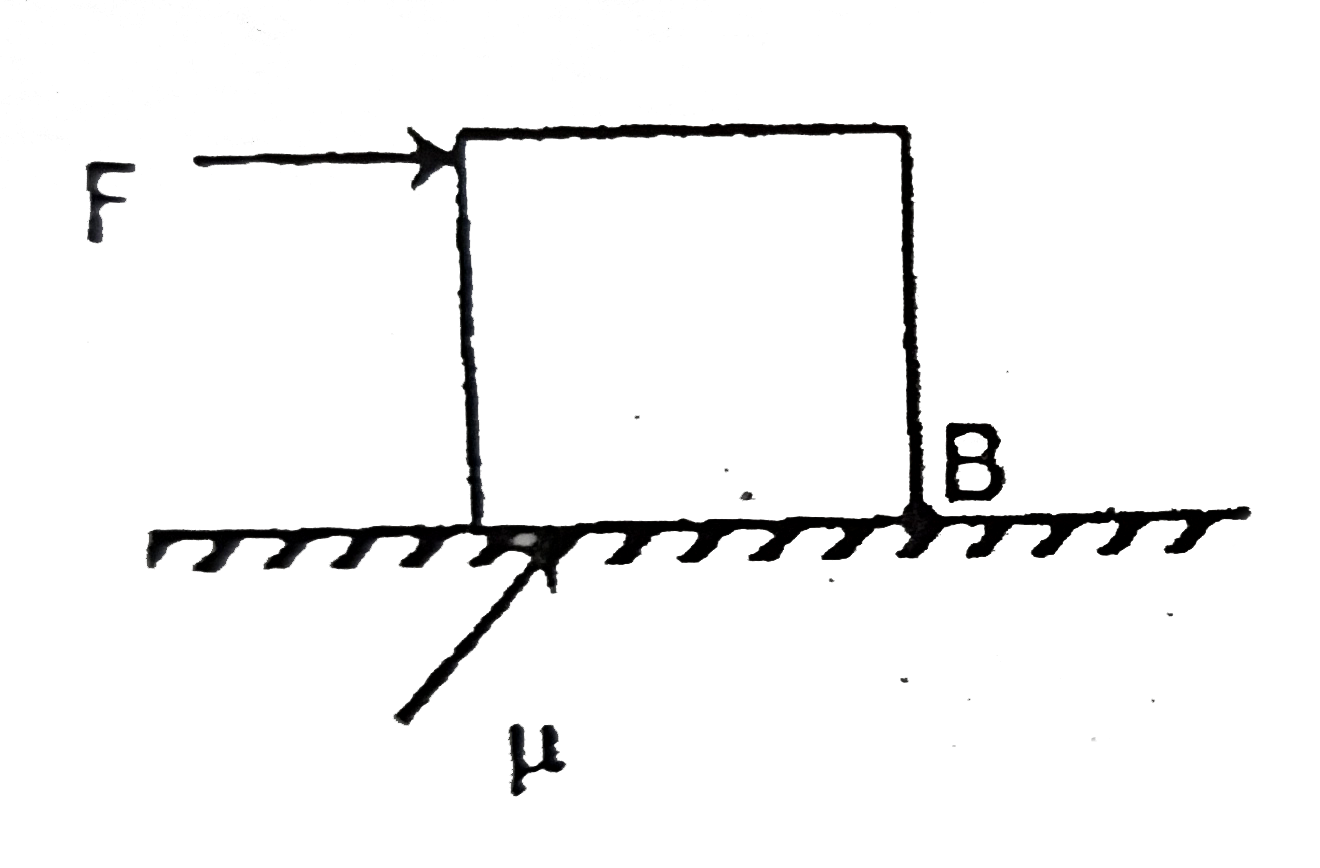A body of mass M is resting on a rough horizontal plane surface the coefficient of friction being equal to μ At t=0 a horizontal force F=F0t starts acting on it , where F0 is a constant find the time T at which the motion starts?
μMg/F0
mg/μF0
μF0Mg
None of these
The correct Answer is:a
To find the time T at which the motion of the body starts, we can follow these steps:
Step 1: Understand the forces acting on the body
The body of mass M is resting on a rough horizontal surface. The forces acting on the body include:
- The weight of the body, mg (acting downwards).
- The normal force N (acting upwards).
- The applied force F which is given by F=F0t (acting horizontally).
- The frictional force, which opposes the motion.
Step 2: Determine the normal force
Since the body is resting on a horizontal surface and not moving vertically, the normal force N is equal to the weight of the body:
N=mg
Step 3: Calculate the limiting friction
The limiting friction flim can be expressed as:
flim=μN=μmg
where μ is the coefficient of friction.
Step 4: Set up the condition for motion to start
For the body to start moving, the applied force F must be greater than the limiting friction. Therefore, we set up the inequality:
F0t>μmg
Step 5: Solve for the time T
To find the time T at which the motion starts, we set the applied force equal to the limiting friction:
F0T=μmg
Now, we can solve for T:
T=μmgF0
Conclusion
The time T at which the motion starts is given by:
T=μmgF0
---
The body of mass M is resting on a rough horizontal surface. The forces acting on the body include:
- The weight of the body, mg (acting downwards).
- The normal force N (acting upwards).
- The applied force F which is given by F=F0t (acting horizontally).
- The frictional force, which opposes the motion.
Since the body is resting on a horizontal surface and not moving vertically, the normal force N is equal to the weight of the body:
N=mg
The limiting friction flim can be expressed as:
flim=μN=μmg
where μ is the coefficient of friction.
For the body to start moving, the applied force F must be greater than the limiting friction. Therefore, we set up the inequality:
F0t>μmg
To find the time T at which the motion starts, we set the applied force equal to the limiting friction:
F0T=μmg
Now, we can solve for T:
T=μmgF0
The time T at which the motion starts is given by:
T=μmgF0
Topper's Solved these Questions
- NEWTON'S LAWS OF MOTION 2BOOK - CENGAGE PHYSICS ENGLISHCHAPTER - NEWTON'S LAWS OF MOTION 2EXERCISE - Multiple Correct
2 Videos
- NEWTON'S LAWS OF MOTION 2BOOK - CENGAGE PHYSICS ENGLISHCHAPTER - NEWTON'S LAWS OF MOTION 2EXERCISE - Linked Comprehension
52 Videos
- NEWTON'S LAWS OF MOTION 2BOOK - CENGAGE PHYSICS ENGLISHCHAPTER - NEWTON'S LAWS OF MOTION 2EXERCISE - Subjective
21 Videos
- NEWTON'S LAWS OF MOTION 1BOOK - CENGAGE PHYSICS ENGLISHCHAPTER - NEWTON'S LAWS OF MOTION 1EXERCISE - Integer
5 Videos
- PROPERTIES OF SOLIDS AND FLUIDSBOOK - CENGAGE PHYSICS ENGLISHCHAPTER - PROPERTIES OF SOLIDS AND FLUIDSEXERCISE - INTEGER_TYPE
2 Videos
Similar Questions
A block of mass 10kg is placed on a rough horizontal surface having coefficient of friction μ=0.5 . If a horizontal force of 100N is acting on it, then acceleration of the will be.
View SolutionA block of mass 10kg is placed on a rough horizontal surface having coefficient of friction μ=0.5 . If a horizontal force of 100N is acting on it, then acceleration of the will be.
View SolutionA block of mass m=5kg is resting on a rough horizontal surface for which the coefficient of friction is 0.2 . When a force F=40N is applied, the acceleration of the block will be (g=10m/s2) .

View SolutionA body of mass 2kg is kept on a rough horizontal surface as shown in the figure. If coefficient of friction is 0.5, find the work done by frictional force in the interval t=0 to t=5sec

View SolutionA block is kept on a rough horizontal surface as shown. Its mass is 2 kg and coefficient of friction between block and surface (μ)=0.5. A horizontal force F is acting on the block. When

View SolutionA cubical box of side length L rests on a rough horizontal surface having coefficient of friction μ. A variable horizontal force F=αt is applied on the top of the block as shown in figure, where α is a constant and t is time. The coefficient of friction is sufficient so that the block does not slide before toppling. The graph between torque due to normal reaction about end B and time before toppling start is

View SolutionA block of mass 20kg is placed on a rough horizontal plane and a horizontal force of 12N is applied. If coefficient of friction is 0.1 the frictional force acting on it is,
View SolutionA block of mass 10 kg is placed on a rough horizontal surface of coefficient of friction 0.1. A pulling force of 100 N acts on it at 37∘ with the horizontal. The frictional force acting on the body is ..... N.
View SolutionA block of mass 2 kg is kept on a rough horizontal floor an pulled with a force F. If the coefficient of friction is 0.5. then the minimum force required to move the block is :-

View SolutionA body of mass m is kept on a rough horizontal surface of friction coefficient μ . A force P is applied horizontally , but the body is not moving .Find the net force F exerted by the surface on the body .
View Solution
